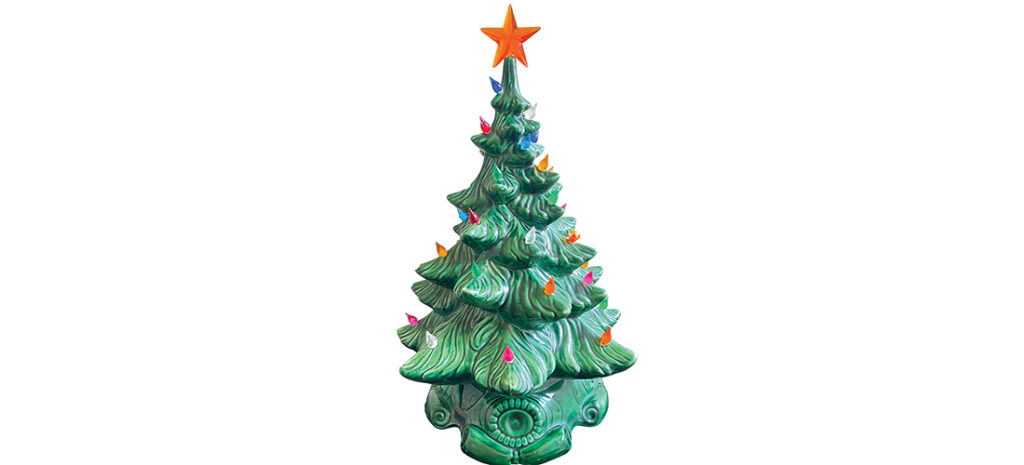Pleasures of Life

The Forever Christmas Tree
What goes around comes around
By Tom Allen
Vintage is all the craze, a buzzword for something that was once outdated but has become desirable and hip. Millennials, remembering those iconic treasures from their childhood, rummage through thrift stores for everything from clothes to kitchen utensils to furniture begging the label “retro.”
Vintage Christmas qualifies. Holiday retro is in high demand. Take your mother or grandmother’s beloved ceramic Christmas tree. Popular in the ’60s and ’70s, by the time the earth-toned ’80s rolled around, the trees lost popularity, partly due to aesthetics, also because bulky cathode ray tube televisions were replaced by flat screens. Where to place Granny’s beloved ceramic tree became a challenge.
My mother was gifted a 12-inch ceramic tree in the early ’70s, crafted by a friend who found a retirement hobby making funky owls and mushroom-embossed napkin holders, at a rural ceramics shop. The tree, dark green and flocked with ceramic snow, held multi-colored translucent plastic bulbs. A 60-watt bulb, screwed into the base, illuminated the tree, which rested on a tea cart in the hallway of my childhood home. The tree was visible, and enjoyed, from my parents’ rocker recliners, but only for a few days in December. My mother, a minimalist before the word found its way into the urban dictionary, decorated a week before Christmas. I still remember the thrill of hearing the click of the tree’s on/off light switch, which produced that instant, multi-colored illumination. Pure joy.
Decorations came down a couple of days after the holiday. An elementary school teacher who cherished her holiday break, Mom disliked anything that might capture dust, like a ceramic Christmas tree. More dust meant more cleaning, and more cleaning meant less time to enjoy her break. Though she and my dad enjoyed the tree for years, her pragmatic side always won out. No 12 days of Christmas for their tree, living or ceramic.
My mother’s last Christmas was spent in hospice care, at an assisted living center. I brought her beloved ceramic tree and placed it on a chest of drawers, easy for her to see and enjoy from her hospital bed. The tree’s lights dissipated some of the room’s darkness and cushioned the sadness of her pending loss. That year, she allowed the treasure to stay up after Christmas. The tree was shining bright when she died on a snowy night in late January.
Mom’s ceramic tree made its way home to our house, where we enjoy those same multi-colored lights from Thanksgiving until late winter. I would leave the tree up year round. Last year my wife drew the line on Valentine’s Day.
No longer relegated to the yard sale bin as they were 30 years ago, mid- to late-century ceramic trees are in high demand. Whether made by a beloved aunt or mass produced in the U.S., don’t expect to snag a tree in your local thrift shop for 10 bucks. Vintage trees can go for several hundred dollars. Newer ones, their production outsourced overseas, are still pricey. Smaller versions can be found at Michael’s or Hobby Lobby. I’ve seen larger beauties at Gulley’s Garden Center in Southern Pines, and even on Etsy and Amazon.
The Vermont Country Store, known as “purveyors of the practical and hard-to-find since 1946,” sells “Made in China” ceramic trees from $15 (5-inch) to over $100 (16-inch). If you’re lucky enough to find one at an antique store, made years ago in the U.S. or by someone’s great-aunt, prepare to pay top dollar.
Our millennial daughters care little for the Barbie ornaments and personalized creations of their childhood, but both have their eyes on Grandma’s ceramic tree. Sorry, girls, gotta wait on that one. PS
Tom Allen is a retired minister who lives in Whispering Pines.
